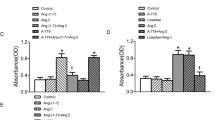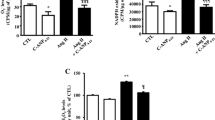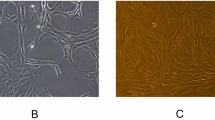Abstract
Angiotensin II (Ang II) dysregulation has been determined in many diseases. The CX3CL1/CX3CR1 axis, which has a key role in cardiovascular diseases, is involved in the proliferation and inflammatory cytokine production of vascular smooth muscle cells (VSMCs). In this study, we aim to explore whether Ang II has a role in the expression of CX3CL1/CX3CR1, thus contributing to the proliferation and pro-inflammatory status of VSMCs. Cultured mouse aortic VSMCs were stimulated with 100 nmol/L of Ang II, and the expression of CX3CR1 was assessed by western blot. The results demonstrated that Ang II significantly up-regulated CX3CR1 expression in VSMCs and induced the production of reactive oxygen species (ROS) and the phosphorylation of p38 MAPK. Inhibitors of NADPH oxidase, ROS, and AT1 receptor significantly reduced Ang II-induced CX3CR1 expression. Targeted disruption of CX3CR1 by transfection with siRNA significantly attenuated Ang II-induced VSMC proliferation as well as down-regulated the expression of proliferating cell nuclear antigen (PCNA). Furthermore, CX3CR1-siRNA suppressed the effect of Ang II on stimulating Akt phosphorylation. Besides, the use of CX3CR1-siRNA decreased inflammatory cytokine production induced by Ang II treatment. Our results indicate that Ang II up-regulates CX3CR1 expression in VSMCs via NADPH oxidase/ROS/p38 MAPK pathway and that CX3CL1/CX3CR1 axis contributes to the proliferative and pro-inflammatory effects of Ang II in VSMCs.




Similar content being viewed by others
References
Cat, A.N.D., A.C. Montezano, D. Burger, et al. 2013. Angiotensin II, NADPH oxidase, and redox signaling in the vasculature. Antioxidants & Redox Signaling 19 (10): 1110–1120.
Kasal, D.A., and E.L. Schiffrin. 2012. Angiotensin II, aldosterone, and anti-inflammatory lymphocytes: Interplay and therapeutic opportunities. International Journal of Hypertension 2012: 829786.
Touyz, R.M., and E.L. Schiffrin. 2000. Signal transduction mechanisms mediating the physiological and pathophysiological actions of angiotensin II in vascular smooth muscle cells. Pharmacological Reviews 52: 639–672.
Montezano, A.C., D.C.A. Nguyen, F.J. Rois, et al. 2014. Angiotensin II and vascular injury. Current Hypertension Reports 16 (6): 431.
Doran, A.C., N. Meller, and C.A. McNamara. 2008. Role of smooth muscle cells in the initiation and early progression of atherosclerosis. Arteriosclerosis, Thrombosis, and Vascular Biology 28: 812–819.
Ragolia, L., T. Palaia, E. Paric, and J.K. Maesaka. 2003. Prostaglandin D2 synthase inhibits the exaggerated growth phenotype of spontaneously hypertensive rat vascular smooth muscle cells. The Journal of Biological Chemistry 278: 22175–22181.
Rudijanto, A. 2007. The role of vascular smooth muscle cells on the pathogenesis of atherosclerosis. Acta Medica Indonesiana 39: 86–93.
Zheng, Lulu, Yongwen Cao, Shao Liu, et al. 2014. Neferine inhibits angiotensin II-induced rat aortic smooth muscle cell proliferation predominantly by downregulating fractalkine gene expression. Experimental and Therapeutic Medicine 8: 1545–1550.
Lucas, A.D., C. Bursill, T.J. Guzik, J. Sadowski, K.M. Channon, and D.R. Greaves. 2003. Smooth muscle cells in human atherosclerotic plaques express the fractalkine receptor CX3CR1 and undergo chemotaxis to the CX3C chemokine fractalkine (CX3CL1). Circulation 108: 2498–2504.
Chandrasekar, B., S. Mummidi, R.P. Perla, et al. 2003. Fractalkine (CX3CL1) stimulated by nuclear factor kappaB (NF-kappaB)-dependent inflammatory signals induces aortic smooth muscle cell proliferation through an autocrine pathway. The Biochemical Journal 373: 547–558.
Xuan, W., Y. Liao, B. Chen, et al. 2011. Detrimental effect of fractalkine on myocardial ischaemia and heart failure. Cardiovascular Research 92: 385–393.
Masztalewicz, Marta, Przemysław Nowacki, Łukasz Szydłowski, et al. 2017. High expression of CX3C chemokine receptor 1 (CX3CR1) in human carotid plaques is associated with vulnerability of the lesions. Folia Neuropathologica 55 (2): 174–181.
Butoi, E.D., A.M. Gan, I. Manduteanu, D. Stan, et al. 2011. Cross talk between smooth muscle cells and monocytes/activated monocytes via CX3CL1/CX3CR1 axis augments expression of pro-atherogenic molecules. Biochimica et Biophysica Acta 1813: 2026–2035.
Moatti, D., S. Faure, F. Fumeron, et al. 2001. Polymorphism in the fractalkine receptor CX3CR1 as a genetic risk factor for coronary artery disease. Blood 97: 1925–1928.
Ikejima, H., T. Imanishi, H. Tsujioka, et al. 2010. Upregulation of fractalkine and its receptor, CX3CR1, is associated with coronary plaque rupture in patients with unstable angina pectoris. Circulation Journal 74: 337–345.
Sun, H.J., et al. 2015. Salusin-beta contributes to vascular remodeling associated with hypertension via promoting vascular smooth muscle cell proliferation and vascular fibrosis. Biochimica et Biophysica Acta 1852: 1709–1718.
Yu, M., Y. Zheng, H.X. Sun, and D.J. Yu. 2012. Inhibitory effects of enalaprilat on rat cardiac fibroblast proliferation via ROS/P38MAPK/TGF-β1 signaling pathway. Molecules 17: 2738–2751.
Savoia, C., D. Burger, N. Nishigaki, et al. 2011. Angiotensin II and the vascular phenotype in hypertension. Expert Reviews in Molecular Medicine. https://doi.org/10.1017/S:1462399411001815.
Khan, M., F. Hassan, S. Roy, et al. 2014. Measurement of reactive oxygen species in cardiovascular disease. Hypertension 49 (4): 359–370.
Cai, H., K.K. Griendling, and D.G. Harrison. 2003. The vascular NAD(P)H oxidases as therapeutic targets in cardiovascular diseases. Trends in Pharmacological Sciences 24: 471–478.
Gan, A.M., E.D. Butoi, A. Manea, et al. 2013. Inflammatory effects of resistin on human smooth muscle cells: Up-regulation of fractalkine and its receptor, CX3CR1 expression by TLR4 and Gi-protein pathways. Cell and Tissue Research 351: 161–174.
Panchatcharam, M., et al. 2010. Enhanced proliferation and migration of vascular smooth muscle cells in response to vascular injury under hyperglycemic conditions is controlled by beta3 integrin signaling. The International Journal of Biochemistry & Cell Biology 42: 965–974.
Ludwig, A., T. Berkhout, K. Moores, et al. 2002. Fractalkine is expressed by smooth muscle cells in response to IFN-gamma and TNF-alpha and is modulated by metalloproteinase activity. Journal of Immunology 168: 604–612.
Kansra, V., C. Groves, J.C. Gutierrez Ramos, and R.D. Polakiewicz. 2001. Phosphatidylinositol 3-kinase-dependent extracellular calcium influx is essential for CX(3)CR1-mediated activation of the mitogen-activated protein kinase cascade. The Journal of Biological Chemistry 276 (34): 31831–31838.
Yang, X.P., R.A. Jones, and J.H. Rivers. 2007. Fractalkine upregulates intercellular adhesion molecule-1 in endothelial cells through CX3CR1 and the Jak-Stat5 pathway. Circulation Research 101 (10): 1001–1008.
White, Gemma E., Thomas C.C. Tan, Alison E. John, et al. 2010. Fractalkine has anti-apoptotic and proliferative effects on human vascular smooth muscle cells via epidermal growth factor receptor signaling. Cardiovascular Research 85: 825–835.
Zhang, Feng, Xingsheng Ren, Mingxia Zhao, et al. 2016. Angiotensin-(1–7) abrogates angiotensin II-induced proliferation, migration and inflammation in VSMCs through inactivation of ROS-mediated PI3K/Akt and MAPK/ERK signaling pathways. Scientific Reports 6: 34621.
Xi, X.P., et al. 1999. Central role of the MAPK pathway in ang II-mediated DNA synthesis and migration in rat vascular smooth muscle cells. Arteriosclerosis, Thrombosis, and Vascular Biology 19: 73–82.
Shen, Y.J., et al. 2014. Cardamonin inhibits angiotensin II-induced vascular smooth muscle cell proliferation and migration by downregulating p38 MAPK, Akt, and ERK phosphorylation. Journal of Natural Medicines 68: 623–629.
Chiou, Wen Fei, Chien-Chih Chen, and Bai-Luh Wei. 2011. 3, 4-di-O-Caffeoylquinic acid inhibits angiotensin-II-induced vascular smooth muscle cell proliferation and migration by downregulating the JNK and PI3K/Akt signaling pathways. Evidence-based Complementary and Alternative Medicine 2011: 634502.
Niess, J.H., and G. Adler. 2010. Enteric flora expands gut lamina propria CX3CR1+ dendritic cells supporting inflammatory immune responses under normal and inflammatory conditions. Journal of Immunology 184 (4): 2026–2037.
Koziolek, M.J., G.A. Müller, A. Zapf, et al. 2010. Role of CX3C-chemokine CX3C-L/fractalkine expression in a model of slowly progressive renal failure. Nephrology, Dialysis, Transplantation 25: 684–698.
Mizutani, N., T. Sakurai, T. Shibata, et al. 2007. Dose-dependent differential regulation of cytokine secretion from macrophages by fractalkine. Journal of Immunology 179 (11): 7478–7487.
Acknowledgments
We sincerely thank Lixue Chen, Wenhui Yan, and Xiaojuan Deng at the central laboratory of the First Affiliated Hospital of Chongqing Medical University for their technical assistance while we conducted our experiments.
Funding
This study was funded by Wu Jieping Medical Foundation (No. 320.6750.16196) and the Medical Research and Developmental Fund of the First Affiliated Hospital of Chongqing Medical University (No. PYJJ2017-02).
Author information
Authors and Affiliations
Contributions
Chengsheng Li and Yunfeng Xia conceived the study and designed the experiments. Chengsheng Li, Jin He, and Xiaoyi Zhong performed all of the experiments. Chengsheng Li analyzed the data and wrote the manuscript. Hua Gan and Yunfeng Xia reviewed and revised the paper.
Corresponding author
Ethics declarations
Conflict of Interest
The authors declare that they have no conflict of interest.
Rights and permissions
About this article
Cite this article
Li, C., He, J., Zhong, X. et al. CX3CL1/CX3CR1 Axis Contributes to Angiotensin II-Induced Vascular Smooth Muscle Cell Proliferation and Inflammatory Cytokine Production. Inflammation 41, 824–834 (2018). https://doi.org/10.1007/s10753-018-0736-4
Published:
Issue Date:
DOI: https://doi.org/10.1007/s10753-018-0736-4




